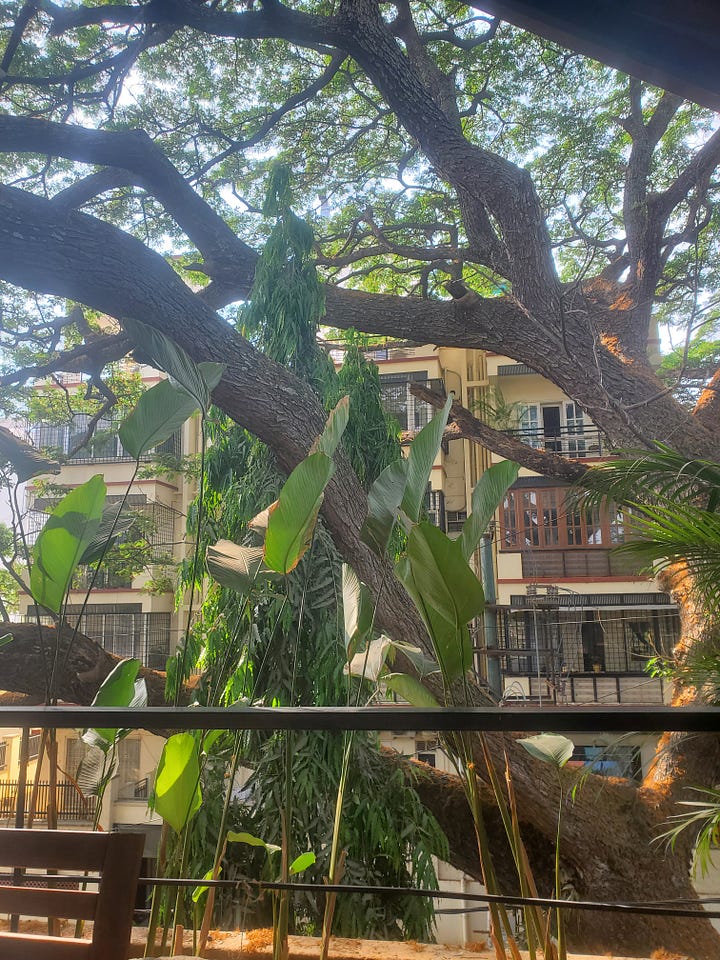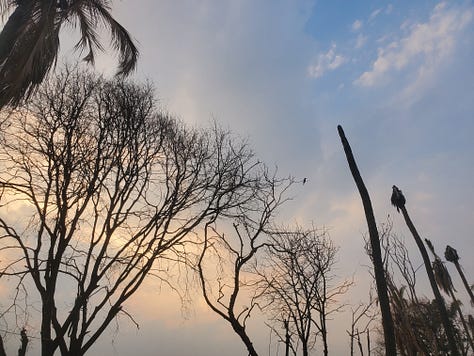In the recent past, I’ve had numerous encounters pointing me to two fundamental recognitions:
things are not as they appear; and
more is not always better.
I realize that these are not new ideas. Many people, including myself, have stated both of them numerous times; but it feels as if life is deliberately reminding me of these truths again and again, for some reason that I don’t yet know. Perhaps the reason is so I will write them down and share them with you. Or maybe I just need to internalise these notions more deeply.
In this post and the next, I will go into a little more detail on these two points, sharing the specifics of what provoked me to recognize them (because maybe you’ll resonate), and some tidbits of context and information to make sense of these realizations. I subtitled this post ‘staying sane’ because these two ideas have been keeping me oriented to what’s real and manageable, like an anchor against the relentless current of hype and buzz all around. May they be helpful to you too.
things are not as they appear
I wrote about this idea from a different perspective in a series of posts on maya from last year.
When I relocated to India last year, I had to start over in numerous different areas of life: from buying furniture, to looking for people to work with, to choosing a new shampoo brand and figuring out where to eat. In each of these contexts and many others, I found myself inundated by recommendations based on marketing hype, which I then had to cut through to find something worthwhile. I’m not sure if it’s because we’re in 2024 and the last time I moved was in 2015, or maybe it’s because India is such a big place with so much going on, but I am distinctly aware that the presence and pervasiveness of extravagant and even fake branding has increased exponentially.
One of the key principles of somatic training, particularly somatic meditation, is that direct experience is the only way to truly know something. In somatics, direct experience refers to perception that is not mediated by concepts, language or thought. It is what your body, your sensory organism, knows directly, without being later interpreted or narrated or somehow fit into your existing box of ideas. These are experiences that we cannot articulate in words, such as the way a piece of music moves us inside, or how the wind on our skin makes us feel like part of the world, or what we know when we hug someone we love.
Direct experience arises from what is called bottom-up processing, which is when your nervous system receives fresh information from your inner and outer environments, usually through your senses, but it can also be through intuition or subconscious material like visions and dreams. Bottom-up processing lies in contrast to top-down processing, which is when your brain or mind organizes your perceptions so that they make sense in the context of what you already know.1
But back to the marketing hype. The greater the gap between the branding of a product or experience and its reality, the greater the dissonance between our bottom-up experience of it and our top-down idea of it. This dissonance drives dissatisfaction, endless seeking, anxiety, frustration and a sense of being estranged from reality.
In the past few months, I’ve burned money on numerous bestselling but ultimately lackluster products and been to several well-marketed yet mediocre events. Likewise, I’ve become aware of famous people who have been exposed or turned out to be frauds, ie. their branded self (or persona) does not match the reality of who they are. Each of these experiences has dropped me, momentarily, into the space between appearance and reality. Nothing is what it seems, or what it presents itself as. And in our upside-down world, presentation often matters more than reality. As I spoke about in my posts on maya, the gap between what is and what appears is actually a doorway into realization and deeper awareness—if it doesn’t drive you mad first.
After a certain number of such encounters, it becomes natural to wonder if I’m the issue. Perhaps my tastes are odd, my standards are too high, or I’m just deviant from the norm in some way.2 But then I’ll find something, quite by accident or by human connection, that is truly spectacular, that touches me deeply and brings me delight—and I know, goodness is out there, it’s just being hidden behind a veil of absurdity and illusion.
In some ways, the presence of the veil makes finding real treasures much more precious. There is an indescribable sensation of gratitude, pleasure, awe even, when something tickles you deep inside: you and I both know it intimately. Yet, at the same time, I wonder, how many people are laboring and creating something genuinely beautiful that hardly anyone gets to see, because of that veil, and because people are more interested in the veil than in reality?
Living in India, I am slowly reconnecting with the ‘old ways’ that people find things—via recommendations from other people that you know and trust. (Substack as a platform has also revived this tradition.) I wrote about this in my first recommendations post: there is something special about being sent something by a friend, or being given a suggestion by someone you meet in person. It may still not land for you, but it gives you a sense of being seen and witnessed in your seeking that you don’t get from app feeds or algorithmically organized playlists.
In the meantime, as I stumble around searching for the right spaces to work out of and the right person to cut my hair, I am embracing all the direct experiences I’m getting to have. Even the ones that turn out to be unsatisfying still have a whiff of the freshness of life about them: they are novel, and fleeting. That’s the wonder of bottom-up processing—your direct experience may be unpleasant, but it’s still something new that has never been felt before, because it exists only in this moment, here and now. At its core, you can’t capture it, not in words nor in images. It’s something else.
dropping into direct experience
I hope you find a way to include more of your direct experience in your awareness and life. It is such a clean, potent counterbalance to the confusion and noise of mind and world as they vie for your attention (and money). Practices like meditation can help, because they familiarise you with the bottom-up state and sensitise you to its pleasure. But so can simply committing to living your life more fully and presently, with your whole organism. For example, you might:
surrender to the music or art you love until it moves you or makes you melt
fully experience the intricacy of simple things like walking, or breathing, or eating
be right there with your friend when he talks to you, noticing the nuances of his speech, gesture, energy and the space between you as you connect
open to the magic presence of animals and plants when you’re out in nature
give in to tiredness and the wonder of sleeping, dreaming and being refreshed every night
The gateways are endless, and utterly unique to you. What counts is that you attend, and take these experiences seriously. Often, simply because we can’t put them into words, such moments lose their potency. Or they become something we keep locked so far inside that we only recognize their value when someone points it out to us. Make them matter, by deliberately making them a part of your life.
When you feel lost in top-down spirals of thought or boxed in by concepts and beliefs, you have two options:
Consciously step outside the confines of mind, by reconnecting with your direct experience, your senses and body (as in the gateways above). This feels like ‘taking a break’ from your own head, and we do this instinctively all the time.
Alternatively, you can ‘trace’ your thoughts and beliefs back to their source—the feelings, sensations, postures, and images that underlie them and give them life. This is harder and can take a little practice, but is a skill worth cultivating or learning from a skilled somatic practitioner. Once you sense that each thought and belief pattern has a tail somewhere in your sensory/emotional/somatic world, it becomes much easier to move through those patterns of thought without getting stuck.
what’s touched me
Increasingly I find that my portals into direct experience come through music, art, deep listening and presence in conversation, and nature. So I’d like to end with a few links to treasures that I’ve found or been given recently, along those lines. I hope you enjoy:
A Message from the Stars, Malte Marten. This beautiful handpan song has been on repeat in my house throughout eclipse season. It is truly a message from the heavens.
This playlist of duduk/flute sounds is what I’m currently writing (and calligraphing) to.
Colin and Samir interview the Mozart of Gen Z (Jacob Collier). This magnificent (and very long) interview goes deep into what it means to be creative, how to engage with an audience, and navigate the ups and downs of public/private life. I am still in awe of the pure enthusiasm and genuine love of craft on display here. It’s such a deep and delightful watch that I’ve been watching and rewatching it in chunks over the course of nearly a month.









Let me know in the comments or via email about your ways to drop into direct experience, and how they make you feel—I always love to hear from you. In my next post, I’ll go into the second of my two (rather obvious) reminders: more is not always better. Stick around for that, and if you appreciate these posts, please like (♡) and consider upgrading to a paid subscription.
Both top-down and bottom-up processing are required to learn anything new and integrate it successfully. Somatics emphasises bottom-up processing as a counterbalance to the excessive ‘headiness’ of conceptual knowledge, which, in the absence of fresh input, tends to go around in loops and never get anywhere. If you’ve ever been stuck in a spiral of anxious thoughts, you know what I mean.
All of these are true on some level, I admit.




I remember a day when I felt unsettled by contradictory statements from supposedly trustable sources about an issue (I guess it was the turmoil in the Middle East). "I don't know what is real", I thought while lying on bed before sleeping. Then, I hugged my wife and I felt relieved because I knew that her love and warmth were very real. It may seem a little childish but I guess we keep a children inside us until we die.
I really like your article, but I can't understand your idea of "tracing your thoughts and beliefs back to their source—the feelings, sensations, postures, and images that underlie them and give them life". If you can develop this idea, I would be very helpful.